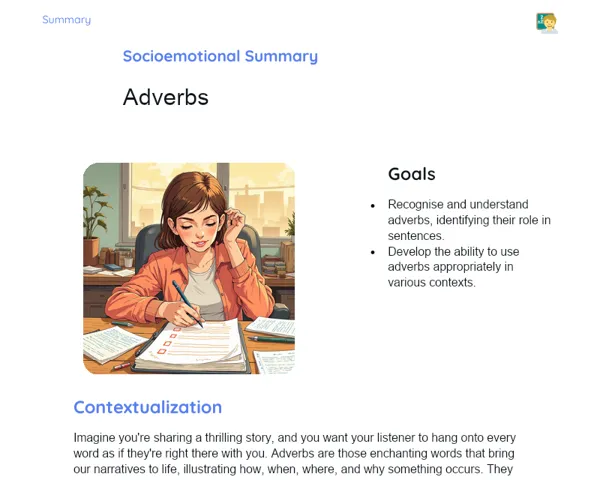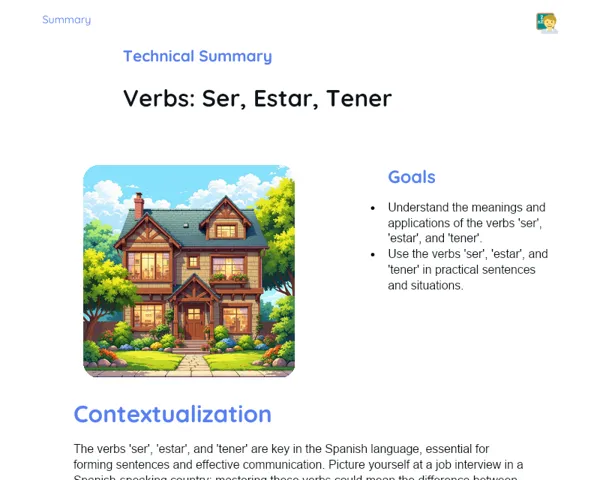Socioemotional Summary Conclusion
Goals
1. 🌟 Develop the ability to use and apply demonstrative and possessive pronouns in sentences and texts in Afrikaans.
2. 🔍 Recognise and identify demonstrative and possessive pronouns in various text types.
3. 🤔 Improve understanding and clarity in communication in Afrikaans, avoiding any confusion.
4. 📝 Strengthen socio-emotional skills by expressing emotions clearly and appropriately, encouraging more empathetic and collaborative interactions.
Contextualization
Picture yourself on a fantastic road trip through a country where Afrikaans is spoken! 🇿🇦 You need to articulate who owns what and point out specific objects. Knowing how to use demonstrative and possessive pronouns makes everything so much easier and more enjoyable! 🎉 Additionally, grasping these pronouns allows us to convey our emotions more effectively, fostering a harmonious and compassionate communication atmosphere. ❤️ Let's tackle these concepts together and gear up for any linguistic adventure that comes our way!
Exercising Your Knowledge
Possessive Pronouns
Possessive pronouns in Afrikaans show ownership and change based on the gender and quantity of the noun they accompany. They are vital for clear and precise communication, expressing relationships and emotional connections with the items and people around us.
-
Weak Forms: Include my, jou, sy, ons, julle. Used directly before the noun.
-
Strong Forms: Include myne, joune, syne, ons s'n, julle s'n. These come after the noun and emphasise possession.
-
Examples: Sentences like 'My boek is op die tafel.' (My book is on the table) and 'Hierdie pen is myne.' (This pen is mine) show how pronouns clearly indicate ownership.
Demonstrative Pronouns
Demonstrative pronouns pinpoint the location of an object relative to the speaker and listener, varying according to the gender and number. They help refer to specific elements in context, enabling precise and efficient communication.
-
Demonstrative Pronouns: Include hierdie (close to speaker), daardie (close to listener), and daargene (far from both).
-
Correct Usage: Examples like 'Hierdie boek is interessant.' (This book is interesting) and 'Daardie huis is groot.' (That house is big) illustrate how pronouns clearly indicate the location of objects.
-
Analogies: Think of being in a shop - if the item is near you, use 'hierdie'; if it's near your mate, use 'daardie'; if it's far from both, use 'daargene'. This simplifies communication.
Socio-emotional Connection
By mastering possessive and demonstrative pronouns, we not only build our language skills but also enhance our ability to express emotions and connect with others. Effective communication helps us avoid misunderstandings and nurture harmonious and empathetic interactions.
-
Expression of Possession: Mastering possessive pronouns helps us pinpoint ownership, making it easier to organise and identify items around us.
-
Location and Reference: Demonstrative pronouns assist in identifying and locating objects, ensuring precise communication and minimising confusion.
-
Socio-emotional Interactions: Clarity in communication is essential to circumvent misunderstandings, fostering more harmonious and empathetic interactions across all contexts, from classrooms to travel and everyday situations.
Key Terms
-
Possessive Pronouns: Used to denote ownership. E.g., my, jou, sy.
-
Demonstrative Pronouns: Used to indicate the location of an object relative to the speaker and listener. E.g., hierdie, daardie, daargene.
-
Weak Forms: Possessive pronouns that precede the noun. E.g., my, jou, sy.
-
Strong Forms: Possessive pronouns that follow the noun. E.g., myne, joune, syne.
For Reflection
-
How can the effective use of possessive and demonstrative pronouns enhance my communication and prevent misunderstandings? Think of a specific example.
-
In what ways can understanding possessive and demonstrative pronouns assist me in articulating my emotions better and grasping the sentiments of others?
-
What strategies can I implement to continue practising and refining my use of possessive and demonstrative pronouns? How can these strategies strengthen my socio-emotional skills?
Important Conclusions
-
🇿🇦 Possessive and demonstrative pronouns are key for clear and effective communication in Afrikaans.
-
📋 Mastering these pronouns allows you to identify ownership and object location, reducing misunderstandings.
-
🖋️ Studying these pronouns boosts our ability to express emotions clearly and appropriately, fostering more empathetic and collaborative interactions.
Impacts on Society
In everyday life, correctly using possessive and demonstrative pronouns in Afrikaans can significantly ease communication, especially in contexts like travel, work, or studying in Afrikaans-speaking areas. Imagine being in a flea market and needing to clarify who owns an item or exactly what you're pointing to. The clarity that comes from correctly using these pronouns can eliminate confusion and make for a more enjoyable experience.
Emotionally, the capacity to express oneself clearly and understand others is critical for building healthy, cooperative relationships. Skill in indicating possession or location not only simplifies communication but also demonstrates respect and consideration for one another, cultivating a more harmonious and empathetic environment. This kind of skill is beneficial in both school settings and social interactions, promoting greater understanding and collaboration.
Dealing with Emotions
To practice the RULER method at home, try keeping an emotions diary while studying possessive and demonstrative pronouns. Start by recognising how you feel during your learning process. Next, understand the reasons behind these feelings, whether they're due to a challenge or a success. Name each identified emotion accurately, like frustration, excitement, or curiosity. Then, express those emotions by crafting sentences such as 'I felt... because...'. Finally, think of strategies to regulate those emotions, like taking breaks, seeking support, or celebrating small wins.
Study Tips
-
📚 Practice daily: Compose sentences using possessive and demonstrative pronouns every day. Small, consistent efforts yield significant results!
-
📖 Read Afrikaans texts: Select short pieces and underline all the possessive and demonstrative pronouns you spot. This will reinforce your learning.
-
🤝 Study in groups: Gather with friends for joint practice. You can work on sentences, identify pronouns in texts, and assist each other in improving.



